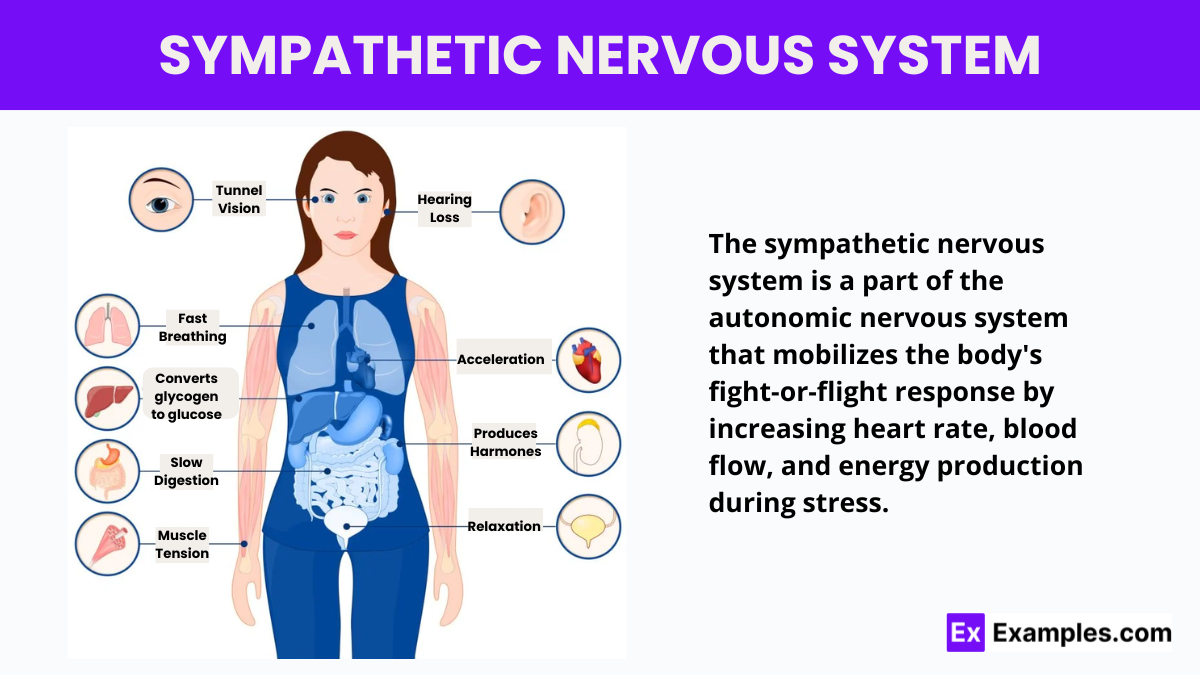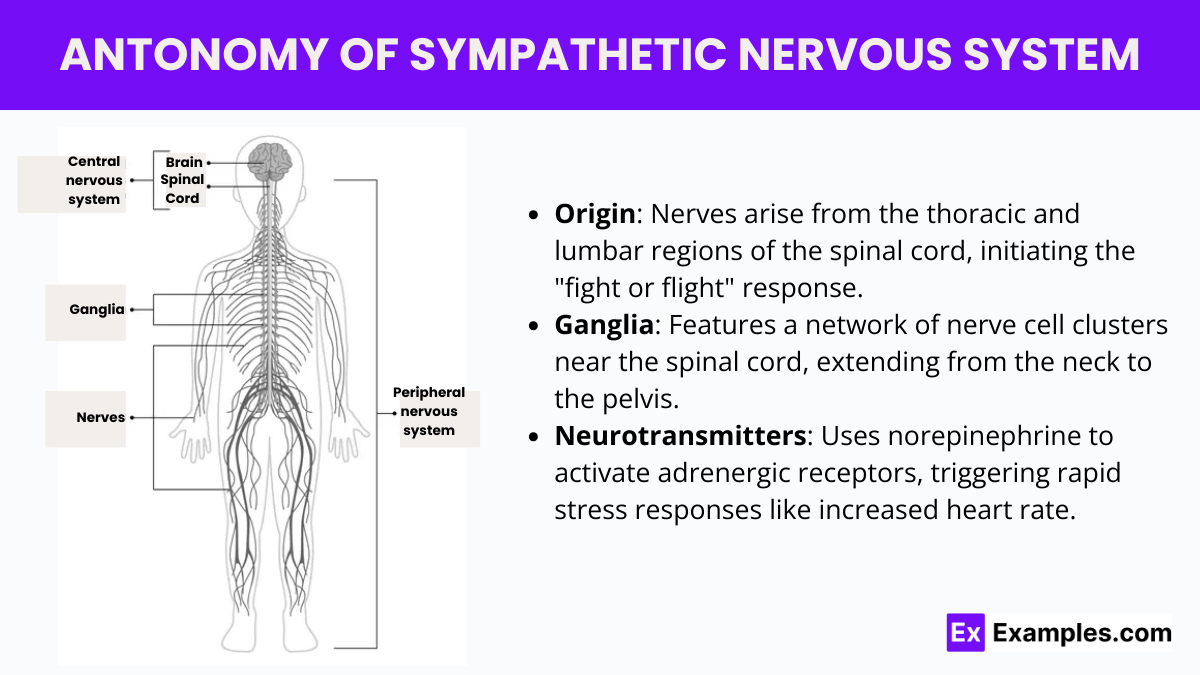What is the primary function of the sympathetic nervous system?
To promote relaxation and digestion
To increase heart rate and prepare the body for stress
To regulate body temperature
To coordinate voluntary muscle movements

The sympathetic nervous system (SNS) is a key part of the autonomic nervous system, primarily responsible for triggering the body’s fight-or-flight response. It functions continuously to maintain homeostasis—keeping internal balance—by regulating critical functions such as blood glucose levels, body temperature, and cardiac output. Acting in opposition to the parasympathetic nervous system, which promotes rest and digestion, the SNS is essential for both immediate survival and long-term health. Its development starts in the embryonic stage and plays a crucial role throughout life, underscoring its importance in health and disease.
The sympathetic nervous system is a part of the autonomic nervous system that activates what is often termed the “fight or flight” response. This system primarily functions to mobilize the body’s resources under stress or in emergency situations, preparing the body to act quickly. It increases heart rate, dilates the pupils, and diverts blood flow away from the digestive system and towards the muscles, enabling a swift response to stressful or dangerous situations.
The sympathetic nervous system (SNS) is a key part of our body’s response mechanism to stress and danger, famously known as the “fight-or-flight” response. This system prepares your body to either face a threat or escape from it by making several quick adjustments in various organs. Here’s a straightforward breakdown of how the SNS impacts different parts of your body:
The SNS functions through a complex network of nerve cells that start from the spinal cord and extend throughout the body. These nerve cells release chemicals like adrenaline and noradrenaline, which trigger these changes in the body organs.
The sympathetic nervous system (SNS) is a key component of the autonomic nervous system, which plays a crucial role in the body’s response to stress or perceived threats. Here are examples of how the sympathetic nervous system influences various bodily functions:
When faced with danger, the sympathetic nervous system triggers the “fight or flight” response. This reaction prepares the body to either confront the threat or flee from it. It involves a surge of adrenaline, increased heart rate, and heightened alertness.
The sympathetic nervous system increases blood pressure to ensure that all body parts receive adequate blood supply, which is essential during emergencies. This is achieved by constricting blood vessels, which raises the pressure of the blood flowing through them.
During a sympathetic response, the pupils dilate (widen). This reaction, known as mydriasis, allows more light to enter the eye, which improves vision in low-light conditions, helping an individual to better assess and respond to a situation.
The sympathetic nervous system plays a critical role in regulating the heartbeat. During stressful situations, it increases the heart rate to boost blood circulation, ensuring that oxygen and nutrients are quickly distributed to vital organs and muscles.
Overall, the sympathetic nervous system primes the human body for rapid, intense activity. It diverts blood from the digestive system and other non-essential functions to the muscles and brain, enhancing physical and mental capacity to handle the stressor.
The sympathetic nervous system inhibits digestion during acute stress. It directs the body’s energy and resources towards more critical functions necessary for immediate survival, such as muscle activity and alertness.
Apart from increasing the heart rate, the sympathetic nervous system also increases the force of each heartbeat. This enhances cardiac output, which is the volume of blood the heart pumps per minute.
Under the influence of the sympathetic nervous system, the muscles of the bladder relax while the sphincters contract. This prevents urination, allowing the body to focus on handling the emergent situation.
During a sympathetic response, the process of digestion slows down or stops. This is because the body prioritizes other functions that are more immediately necessary for dealing with stress.

The sympathetic nervous system (SNS) is a branch of the autonomic nervous system that is activated during stress or emergencies, preparing the body for rapid action. Here is an overview of the anatomy of the sympathetic nervous system, accompanied by a diagram to illustrate its main components.
Disorders of the sympathetic nervous system can manifest a range of symptoms that affect various body functions, primarily those related to the body’s response to stress or emergency situations. Here are the key symptoms and effects associated with such disorders:
The sympathetic nervous system triggers the “fight or flight” response, while the parasympathetic restores the body to a state of calm.
Actions include increasing heart rate, dilating pupils, slowing digestion, expanding airways, and releasing adrenaline.
Causes include stress, anxiety disorders, neurological issues, and certain medications that stimulate nervous system activity.
Stimulation leads to increased alertness, energy, and readiness for physical activity, enhancing the body’s ability to respond to stress.
Text prompt
Add Tone
10 Examples of Public speaking
20 Examples of Gas lighting
What is the primary function of the sympathetic nervous system?
To promote relaxation and digestion
To increase heart rate and prepare the body for stress
To regulate body temperature
To coordinate voluntary muscle movements
Which neurotransmitter is primarily associated with the sympathetic nervous system?
Acetylcholine
Norepinephrine
Serotonin
GABA
How does the sympathetic nervous system affect the digestive system?
It enhances digestion and absorption
It decreases digestive activity
It has no effect on digestion
It directly stimulates digestive enzyme secretion
Which of the following physiological responses is NOT typically associated with the sympathetic nervous system?
Increased pupil dilation
Increased salivation
Increased heart rate
Increased blood flow to muscles
In which part of the spinal cord are the sympathetic nerve fibers primarily located?
Cervical region
Thoracic and lumbar regions
Sacral region
Coccygeal region
What is the role of the adrenal glands in the sympathetic nervous system?
To produce insulin
To regulate blood pressure
To release adrenaline and norepinephrine
To control muscle contractions
How does the sympathetic nervous system influence the respiratory system?
It decreases respiratory
It increases respiratory rate
It has no effect on respiratory rate
It causes irregular breathing patterns
Which of the following is a common effect of sympathetic nervous system activation?
Decreased blood sugar levels
Increased perspiration
Increased digestion
Decreased heart rate
How does the sympathetic nervous system affect blood vessels?
It causes vasodilation
It causes vasoconstriction
It has no effect on blood vessels
It decreases blood flow to the heart
Which organ's function is directly regulated by sympathetic nerve fibers through the release of norepinephrine?
The liver
The stomach
The pancreas
The kidney
Before you leave, take our quick quiz to enhance your learning!

